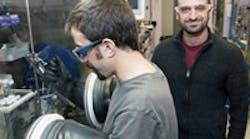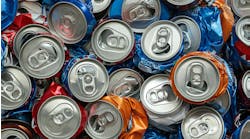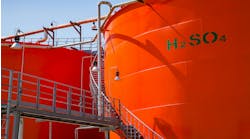CATALYST RESEARCHERS
Figure 1. Graduate student Thomas Mazzacano (foreground) and Neal Mankad, assistant professor of chemistry (right) developed a way to break hydrocarbon bonds using copper and iron. Source: Roberta Dupuis-Devlin, UIC Photo Services.
The design approach — using two base metals to mimic a single-site noble-metal catalyst — may suit organic syntheses beyond borylation, they believe. Such a base-metal catalyst not only would cut costs but also toxicity issues, they add. The dual-metal catalyst eventually could become a drop-in replacement for precious metal catalysts, the researchers hope.Borylation conventionally involves iridium taking the two electrons that form the carbon-hydrogen bond and adding them to a boron atom to bind it to the carbon. The UIC team found that copper and iron, when placed close together, are able to take care of the two-electron reactions. More details appear in a recent article in the
Journal of the American Chemical Society."Using copper and iron for catalyzing these reactions that are necessary for making so many of the things we rely on every day will benefit the environment and help bring costs down," says Neal Mankad, an assistant professor of chemistry, who developed the process with graduate student Thomas Mazzacano. "Copper and iron are abundant and cheap — and don't have to be so completely purified out of end products, unlike the noble metals, because they are less toxic."The researchers are now working to make their strategy more practical, to compete with traditional precious metal catalysts. They are particularly focused on overcoming some of the limitations of the new technology. For instance, borylation using their catalyst requires ultraviolet (UV) irradiation, a rigorously anaerobic environment and neat substrate."Without addressing these, there is no way for our base-metal systems to compete directly with their noble-metal counterparts," notes Mankad. However, he believes subtle catalyst modifications can address these concerns. The researchers also aim to pursue one-pot/one-catalyst reactions. "The idea here is that a) our Cu-Fe catalysts already convert hydrocarbons into boronate esters, b) there are several known Cu-catalyzed transformations of boronate esters, and so c) there is hope that the same catalyst can both produce and consume the boronate esters in the same reaction vessel. Ultimately, we hope that this will allow for one-pot/one-catalyst reactions that convert C-H bonds to various C-X bonds (via C-B intermediates that don't require isolation) with sterically controlled regioselectivity — and all without requiring any precious metal resources along the way," he explains.Other reactions the team is working towards include C-C coupling reactions and reductions of unsaturated substrates including carbon dioxide. "These are reaction types that often use homogeneous catalysts based on noble metals like Pd, Rh, Ir and Ru. Being able to achieve them with earth-abundant catalyst materials not only would be an important contribution, it would highlight that our catalyst design strategy can be generalized to many applications," notes Mankad.In some cases yields are comparable to those achieved by noble-metal catalysts, but are lower in others. So, in the ongoing research to address the air sensitivity and other practical issues, Markad notes, "…we will simultaneously aim to optimize some of the yields and also expand the substrate scope so a wide variety will be compatible with our technology."Making the dual-metal catalyst on a large scale does pose some issues. "Our catalysts consist, in crude terms, of a cationic half and an anionic half. The anionic half must be synthesized under extremely reducing conditions such as alkali metal reduction. This is not a practical synthetic approach on large scale, due to air sensitivity and safety hazards. It is likely that more-friendly synthetic methods can be developed, but so far our focus has been on developing catalytic applications," he says.



